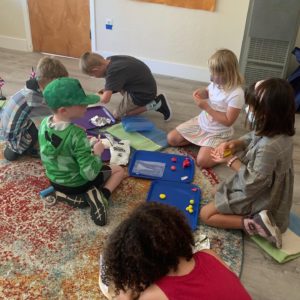Frequently Asked Questions
What is Godly Play?
Godly Play offers a creative, child-honoring way of entering into and experiencing the biblical story. In Godly Play, we play with the language of God and God’s People: our sacred stories, parables, liturgical actions and silence. Through this powerful language, through our wondering, through the community of players gathered together, we hear the deepest invitation of all: an invitation to come play with God.
For more information you can go to the Godly Play Foundation website.
What makes Godly Play distinctive?
In Godly Play, we tell Bible stories to encourage children to enter the stories and relate them to their personal experience. It is concerned with the spiritual development of each child as an individual.
When we arrive on Sunday, what do we do?
Toward the end of the 9:00 AM family-centered worship service (around 9:45), children age 4 through 2nd grade will process with a teacher and adult assistants to the Godly Play classroom (room 3). Parents can pick them up between 10:30-10:45 AM.
We treat the Godly Play classrooms as a “sacred space.” Greeters help each child at the door become ready to enter the room quietly.
What kinds of projects will my child do in Godly Play?
After the lesson, the teacher and children wonder together about the story, and enjoy a feast (e.g., bagels, crackers, juice and water). Then, each child chooses how to respond to the lesson with art or lesson materials. Also, we often prepare a related activity or craft to complement the story. We encourage children to take time on their projects.
What are on the shelves in the classrooms?
These objects are the lesson materials that make the images of religious language come alive. In Godly Play, the teacher (storyteller) sits in the circle with the children. The materials help us tell the story of the day and are placed in the middle of the circle, symbolizing the fact that God is present and accessible to all, children and adults alike. Working in the circle also helps us emphasize many aspects of being together in a Christian community.
Will my child enjoy Godly Play?
One of the goals of Godly Play is to create a safe space for children a place where their ideas, opinions, and gifts are deeply respected. Because everything in the classroom is designed for children to use and enjoy, most children look forward to coming to Godly Play
Ways That You Can Help with Godly Play
Door Monitors
The door monitor plays a critical role in the program, but the job is not difficult. The door monitor does no work outside of class.
During the final song of the 9:00 service, the door monitor heads to the classroom and prepares to greet the students. He or she lays helps to organize the room and waits for the students to arrive. As each child enters the classroom, the monitor greets the child, and asks them to take a deep breath and prepare themselves for the lesson.
During the lesson, the door monitor helps quietly remind louder students to be ready, distributes clay or other fidget toys as needed, and returns students to their parents if necessary.
Following the story we ask the children “what was the most important part” and “what part could be left out”? The door monitor listens as each child tells the teacher what work would help them best respond to the story, and facilitates distribution of materials. (Clay, paper, story pieces.) After cleanup and the feast, the door monitor assists children with reconnecting with their parents.
Godly Play Teacher/Story Teller
This job is perhaps the most frightening to volunteer for, but also one of the most rewarding. At a short training in the fall, the Godly Play teacher learns the process for teaching the stories of our faith to the children. Each story is scripted and comes with carefully prepared materials to engage the children and their sense of wonder. The Godly Play teacher is responsible for reading the story before arriving at church on Sunday. Ideally the teacher would memorize it, but the reality is you can just print it out and read it as-is and the words and materials will capture the attention of the children. The teacher makes sure he or she is familiar with the materials Sunday morning before church, and asks another story teller or the materials coordinator for help if needed. The door monitor is always available to help the teacher with classroom issues. Frequently an individual volunteers to be a door monitor for a year or two before becoming a story teller.
Requirements
Any adult working directly with children should be willing to submit to a background check and complete Safe Guarding God’s Children (per Diocesan guidelines).
Questions email admin@sttims.org


